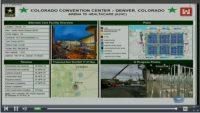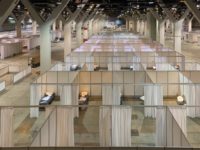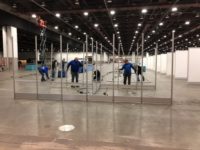On March 24-25, Guarantee Electrical in St. Louis set up and installed power for a COVID-19 drive-through testing station at St. Luke’s Hospital in St. Louis.
Workers had to run power approximately 700 ft from the main building to a 200-amp panel and a 100-amp feed for one of the site’s two powered trailers. The electrical contractor also installed lighting and heaters in a testing tent and in two auxiliary tents.
“With the help of our prefabrication team, tools, warehouse and suppliers, I was able to get all of the materials I need to me early on Monday morning,” says Dave Gralike, president of Guarantee Electrical. Contractor McCarthy Construction oversaw delivery of a small generator and Guarantee had temporary power fully installed by mid-morning of March 30 in order to bring the testing site online on March 31.
For ENR’s latest coverage of the impacts of the COVID-19 pandemic, click here
Guarantee also worked as part of the team that converted a Quality Inn in Florissant, Mo., into a COVID-19 alternate care facility for the Federal Emergency Management Agency and the Army Corps of Engineers. Electrical modifications to the hotel included temporary power and lighting, alterations to in-room phone systems and coordinating power and mechanical system modifications to ensure patient rooms had the necessary air handling capacity to provide negative air pressure.
It's one of 50 alternate care facilities the U.S. Army Corps of Engineers has delivered to date for the Federal Emergency Management Agency to care for low and moderate-risk COVID-19 patients and other patients to take the strain off hospital systems. 12 More are still being constructed. The USACE has delivered 14,779 beds in hotels, college dormitories, convention centers and arenas for cities and towns with high coronavirus infection rates at a total cost of $1.8 billion to date. The ability of contractors to quickly prefabricate and deliver mechanical, electrical and medical gas systems has enabled such a quick turnaround.
Rapid Prefabrication and Delivery
“While we’ve been working prefab for decades, in the last 10 to 15 years, we’ve brought our prefabrication operations up to an entirely different level, both prefabrication and modularization,” Gralike said. “We run about 15 [people in the St. Louis prefabrication shop]. The numbers would get higher than that as far as people required if we were doing some modularization like head walls or big racks.”
Other alternate care facilities have called for similar fast turnarounds, such as the custom air handling system that was fabricated and installed in Chicago’s McCormick Place Hall B in only two days by HVAC subcontractor Mechanical Inc. of Freeport, Ill. Patrick Engineering of Chicago turned a standby electrical system meant only be used for electrical loading during short-term large events into a full-time permanent upgrade. This quick adaptation allowed Detroit’s TCF Center to operate as a COVID-19 alternate care facility with proper negative air pressure. The upgrade required the system to be reprogrammed and connected into an existing switchgear.
The TCF Center conversion also involved an upgrade of what was originally designed as an optional standby electrical system that could also operate in parallel with Detroit’s Power and Light Department for load management, utility demand response, and transition between generators and PLD-provided power. Due to the existing downstream utility customers still being on the system, the generator system was modified to operate manually with coordination between TCF personnel, who controlled the generator, and PLD system operations, who controlled all the circuit breakers of the facility switchgear.
To meet back-up power requirements for the alternate care facility, automatic operation was required, which involved rewriting the control system program and extensive testing and verification under simulated conditions. After verification, the new system was connected to the main switchgear, which involved current, voltage, control, and status for the three main circuit breakers, along with control and status for two tie circuit breakers and seventeen feeder positions.
“Everyone—public and private, federal, state and local—has understood the magnitude of the need and responded in great fashion,” says Col. Marvin Griffin, commander of the Corps’ engineering and support center.
Griffin says specialty contractors have managed to deliver a combination of piped and distributed medical gas in arenas and convention centers, using existing grid layouts of utilities and connection points. This includes 400 ft of copper piping installed in the TCF Center. Griffin says this approach has proved beneficial to the mission of getting these temporary medical facilities up and running quickly.
Convention centers work well as COVID-19 alternate care facilities because most have access points with water, electric, sewage and IT services in their floors every 20 to 30 ft on center, said Col. Aaron Reisinger, commander of the Corps Chicago District. Reisinger gave the requirements to design consultants Stantec and Environmental Systems Design for an independent air-circulation system and an oxygen-supply system for McCormick Place's Hall B, the part of the alternate care facility designated for moderate to more severe patients with COVID-19. Each patient pod in Hall B has a HEPA filter that treats the air before it leaves the space.
"The reason for putting these patients in negative air pressure is to protect the healthcare workers and maintain and isolate the density of the virus within that isolation pod. Each of those patients would be in a contained isolation unit with negative pressure," Reisinger says.
The ability to quickly go from design to fabrication to installation has been crucial in the design and construction of COVID-19 alternate care facilities, testing sites and other temporary structures built to deal with the pandemic. Stantec and ESD's HVAC system was turned around and ready for installation in two days after rapid fabrication at Mechanical Inc.'s Rockford, Ill., fabrication shop. The pieces were fabricated and delivered so that general contractor Walsh Construction never had to have more than two crew members carrying them so they could social distancing on the project.
"Our fabrication equipment is automated enough that it's really mostly machine and not many people," says Brian Helm, president of Mechanical, Inc. "We're easily able to maintain the 6-ft separation in the fab shop. It gets a little harder on the site, but we built ducts in what we call schools, so they're from 10-ft to about 25-ft lengths that we fabricate in the shop. When we deliver it, if you have a person at each end, you're maintaining the 6-ft separation."
Amy Marks, the founder of XSite Mobile hired by Autodesk in March to lead its industrial construction technology business, said that mechanical, electrical and plumbing trade subcontractors who have invested in prefabrication shops and technology are at an advantage in rapid construction situations and the general contractors who work with them that have set processes for delivery and fast installation are also ahead of contractors who strictly field fabricate.
“Those fab shops can actually pull across the entire three buckets [design, construction and delivery] and be an integral part of all three because they are currently set up to fabricate, pieces and parts mostly,” Marks says. “The long-term need for those beds can come from a combination of the subcontractor base that are making, building those pieces and parts. Additional factories need to be set up to do modular if you want to go to the modular delivery level, or even fabricate just the patient rooms themselves.”
Both Helm and Gralike said the ability to receive shop drawings in Autodesk Revit allowed their personnel to quickly turn fabrication around thanks to rapid communication over their vendors' cloud-based systems. Both companies cited decades of investment in both software and their physical shops as key to doing healthcare work in general and the COVID-19 facilities in particular.
"We were fortunate that almost every one of our systems now is on the cloud," Gralike says. "So, whether it be Viewpoint or Revit or, obviously, our Office 365 is on the cloud. Our manpower, which is called LaborChart, is on the cloud. So there's really no information that you can't get to from your phone or from your house in our operation."
What Happens After the Mission’s Accomplished?
To manage logistics for the delivery of the Corp's hotel, dormitory, convention center and arena alternate care facilities, logistics and opening are defined as wrap-around services in the FEMA contracts. AECOM had the wrap-around services contract for the 1,500-bed McCormick Place alternate care facility and served as owner’s representative for Chicago.
“Everything that hadn't gone into the original planning that the Corps had done… there weren't air locks to get in and out of the space, locker rooms, storage areas for all the supply chain, we did that essentially,” says Bane Gaiser, managing principal and senior vice president in AECOM’s Chicago office. “We worked with the city [of Chicago] to set up all of the contracts that were needed to have this a fully functioning facility.”
The services needed included food service, supply chain management, medical equipment, medical waste disposal, staff screening and even getting the license to operate a pharmacy.
A forward command center was set up on site while general contractor Walsh Construction was still working on delivering the facility and Gaiser, AECOM staff and city personnel began the process of preparing for the alternate care facility’s opening.
The City of Chicago funneled its requests through the state of Illinois to FEMA and then FEMA would respond. The first 500 beds were originally going to be outfitted with functional movement screen sets, which are emergency medical tool sets that are ready to be deployed but that turned out to not be necessary. Cots, intravenous drip poles, chairs, wheelchairs and other materials were needed.
“We received things like that from FEMA,” Gaiser says. “We received some pharmaceutical supplies to start off. It came in and at haphazard fashion. We didn't always know what was coming when but as soon as we had it, we'd put it into the plan and figure out how to handle it.”
Gaiser says he saw his role as being the glue to make sure that those gaps were filled. After two weeks of construction, logistics and training staffed recruited by DuPage Medical Group, the McCormick Place alternate care facility opened its first 500 beds on April 20.
“We did a debrief that evening after we had patients in there and had really tested the facility with them,” Gaiser says. “The only thing that was a concern was that we might not have the right supply of wipes, which is part of the operation of making sure that your equipment is clean. We had them, but we were worried that we didn't have enough for the long term. I felt pretty good when that that was the thing that we were concerned about at that point.”
Gaiser said AECOM and Chicago have already begun planning to turn McCormick Place back into a convention center. While the electrical upgrade at the TCF Center in Detroit is a permanent upgrade, it will go back to being an arena at some point.
The total cost of converting the 62 alternate care facilities that USACE is delivering is $1.8 billion, 75% of which is covered by FEMA’s budget and the remaining 25% met by the state and local authorities asking for an alternate care facility. States can reduce their 25% share by applying for designation as a federal disaster area and Michigan, which has already received a disaster declaration from President Trump, has written to the FEMA administrator asking for relief. The total cost of the McCormick Place facility was $15 million and the TCF Center’s cost was $11.7 million. The Corps insists it’s getting the taxpayers the best deal it can under the circumstances.
“Most of the time, we're able to stay within that budget. Now, if the mayor really wants this done faster than we can and you've got to work a 24-hour shift than maybe a 12-hour shift that cost might go up. My team that works with FEMA is involved in those discussions,” Lt. Gen. Todd Semonite, chief of engineers and commanding general of the USACE, said at an April 17 news conference on the alternate care facilities. “But I’ve got to admit, I love working for FEMA. Money has not been an issue with necessarily FEMA here when it comes to saving lives. And I think that's the right call.”
Semonite also said the Corps goes out of its way to competitively bid the alternate care facilities, and makes sure it’s getting contractors that are certified and can deliver the work. All of the contracts are issued in accordance with the Federal Acquisition Rules.
For Marks, the entrepreneur in construction prefabrication who has previously served as the Singapore Building & Construction Authority’s expert overseeing its construction roadmap, the lessons the construction industry takes from the rapid build out of these 62 alternate care facilities need to include how to better prepare hospitals to handle the next pandemic. The techniques and capabilities that helped deliver these rapid-response facilities should inform the future construction of more permanent healthcare beds for mid-range and long-term solutions, she says.
“The smarter contractors, the smarter subcontractors, and the smarter firms are connecting these dots,” she says. “We need to reinforce the behavior and we need the government where all this stimulus is coming from…we need them to insist on the behavior."






Post a comment to this article
Report Abusive Comment